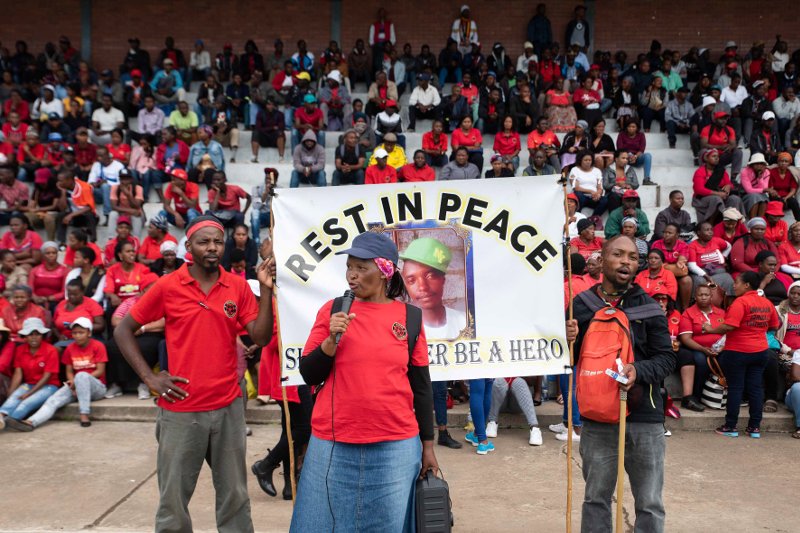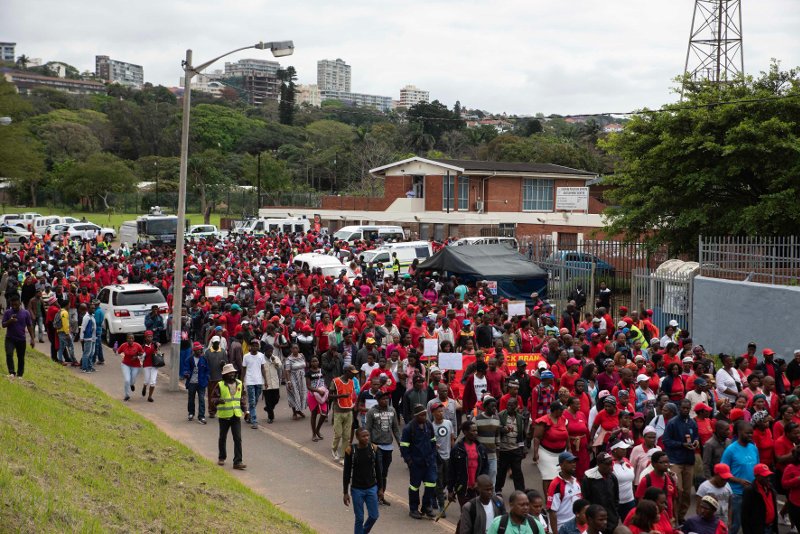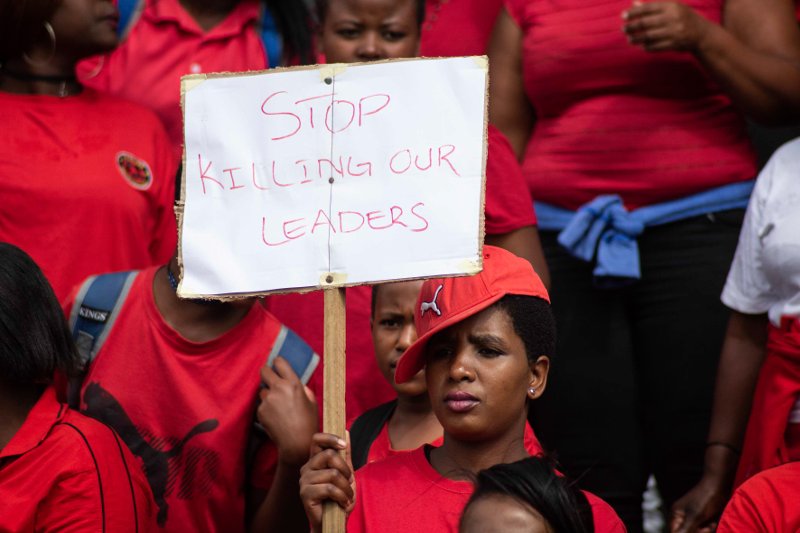
Source: New Internationalist
On Monday October 8 thousands of members of Abahlali baseMjondolo, supported by organized migrants and street traders, as well as trade unionists, marched on the Durban City Hall in protest against serious repression in the South African city, including assassinations.
Abahlali baseMjondolo – which means ‘residents of the shacks’ – is, by a considerable distance, the largest and best organized and sustained popular movement to have emerged outside of party politics and trade unions after the end of apartheid. The movement was formed in Durban in 2005. It immediately confronted intense hostility from within both the ruling African National Congress (ANC) and a middle class left located in NGOs.
In both cases assumptions of an automatic right to represent impoverished black people, and a deeply prejudicial set of assumptions about the political capacities of these people, resulted in the new movement being presented through paranoid colonial ideas about criminality and external manipulation.
From the outset the democratic rights affirmed as universal entitlements in post-apartheid law were not extended to Abahlali baseMjondolo. Protests were summarily banned, and repressed with serious violence, including the use of live ammunition. The new movement was offered two choices by the local state if it wanted to be treated as a legitimate actor: it either had to submit itself to the authority of the ANC, or an NGO approved by the ANC.

When it became clear that the new movement would not surrender its autonomy to the ANC they were told, in 2006, to either join the NGO Shack Dwellers’ International (SDI) or face arrest. Their refusal to join SDI quickly resulted in arrests, and severe assaults in police custody.
Repression escalated in September 2009 when the movement was attacked by armed men in the Kennedy Road settlement, where they had their office. These men identified themselves as ANC supporters and, also, in ethnic terms. The armed mob was able to act with police support and as soon as key leaders from the movement had been removed from the settlement senior politicians arrived to reclaim it for the ANC. The movement was denounced as a criminal organization and it was declared that it had been ‘disbanded’.
Shortly after the attack 12 members of a dance group affiliated with the movement were arrested. For months after the initial attack armed ANC members gathered at the settlement on Sundays to destroy the homes of people known to be associated with the movement. The police refused to intervene.
After the attack the movement faced a situation in which its leaders were subject to open death threats and it had to organize underground. Middle class solidarity was negligible and there was an intense existential sense of isolation and vulnerability.

The 12 men arrested after the attack spent months in prison, where they were subject to serious assault. When the case finally came to court the judge threw it out, and described the state’s witness as ‘unreliable’ and ‘dishonest’. It had been a brazen and crude frame-up. It was so crude it opened wider avenues for solidarity from within the media, the academy and some NGOs.
The state massacre of striking miners in Marikana in August 2012 fundamentally changed politics in South Africa in and out of Parliament. Across the country there was a discernible break down in the moral authority of the ANC and in a number of towns and cities new land occupations were named ‘Marikana’.
In 2013 a new land occupation in Durban, in Cato Manor, where the ANC had, in the late 1950s, first began to build popular support in Durban was named ‘Marikana’. From the start the occupation, organized in a place of deep symbolic significance for the ANC, and adjacent to what had been a white suburb under apartheid, was acutely contested.
In March that year Thembinkosi Qumbelo, a local activist involved in the occupation, was assassinated. He was not a member of Abahlali baseMjondolo, who were also supporting the occupation. Nkululeko Gwala, a local Abahlali baseMjondolo leader, was assassinated in June. In September Nqobile Nzuza, an unarmed 17-year-old, was shot dead by the police at a road blockade organized in opposition to repression.

There were no arrests for the assassinations of Qumbelo and Gwala, and no evidence of any serious police investigation. However, after sustained organization and struggle, a police officer was eventually convicted and sentenced for the murder of Nzuza.
Repression continued into 2014. In September Thuli Ndlovu, an Abahlali baseMjondolo leader in KwaNdengezi, was assassinated. After sustained pressure from below two local ANC politicians were eventually arrested and sentenced for the assassination.
But in 2017 repression worsened. A number of people were seriously injured, some fatally, during evictions, disconnections from self-organized connections to water and electricity and protests. In November S’bonelo Mpeku, an Abahlali baseMjondolo leader in a land occupation in Lamontville, was abducted from his shack and stabbed to death. In December two prominent young activists were shot in a land occupation in Cato Manor one, Soyiso Nkqayini, died.
Repression continued in 2018. In May S’fiso Ngcobo, an Abahlali baseMjondolo leader in a land occupation in Marianhill, was assassinated. The following month the Mayor of Durban, and the ANC’s chief whip in the Municipality, made open threats against the movement, and prominent activist S’bu Zikode. After information of an imminent hit on Zikode was received from various sources he had to go underground, again.

The scale at which Abahlali baseMjondolo, which now has tens of thousands of members and active branches in five of South Africa’s provinces, has been able to organize is unique. It’s capacity to sustain organization over time and through waves of repression is also unique. But the violence that the movement confronts is not.
The policing of land occupations, self-organized connections to water and electricity and protest in South Africa in general, and Durban in particularly, is routinely brutal and serious injuries and deaths at the hands of the state are not uncommon.
Other organizations have also been subject to assassination. In 2014 three local leaders in the National Union of Metalworkers of South Africa were assassinated in Isithebe outside Durban. At least four members of the South African Communist Party have also been assassinated in and around Durban since 2014. A recent report in the New York Times, focussing on assassinations within the ANC, concludes that around 90 politicians have been assassinated as a result of intra-ANC contestation since 2016.
Political violence, including death threats, and assassinations, has been normalized in Durban. Organizing on this terrain takes real courage. Abahlali baseMjondolo are not wrong to lament that, almost a quarter of century after the end of apartheid, ‘the price for land is paid in blood.’
Richard Pithouse is an Associate Professor at the Wits Institute for Social and Economic Research at the University of the Witwatersrand in Johannesburg. He is also a journalist, and the editor of New Frame.
